Help with WWVB Radio Controlled Clocks
Update 11 October 2024: As of 10 October 2024, 2300 UTC, WWVB is operating at full power.
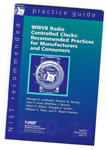
To find out more about WWVB radio controlled clocks, please download this 64-page PDF booklet:
WWVB Radio Controlled Clocks: Recommended Practices for Manufacturers and Consumers (NIST Special Publication 960-14, August 2009)
You may also receive a printed copy by kathryn.stephenson [at] nist.gov (subject: Please%20send%20me%20a%20copy%20of%20SP960-14) (sending your mailing address) or by calling (303) 497-4343.
| How They Work | Where They Work | What to Do When They Don't Work | Manufacturers of Radio Controlled Clocks |
By now, you have probably seen or own a radio controlled clock. These clocks are sold in all forms: as wall clocks, desk clocks, travel alarms, and wristwatches. They have a tremendous advantage over conventional clocks, they are always right! When working properly, radio controlled clocks always display the correct time, down to the exact second. This means that you should never have to adjust them. During the transition from standard time to daylight saving time (DST) they "spring forward" one hour, and when DST is finished they "fall back" one hour.
Due to technology advances and the economies of scale, radio controlled clocks are now very inexpensive, often costing just a few dollars more than conventional clocks. This page provides information about radio controlled clocks, including how they work, where they work, and what to do when they don't work.
How They Work
Some manufacturers refer to their radio controlled clocks as "atomic clocks", which isn't really true. An atomic clock has an atomic oscillator inside (such as a cesium or rubidium oscillator). A radio controlled clock has a radio inside, which receives a signal that comes from a place where an atomic clock is located.
In the United States, the signals received by radio controlled clocks originate from NIST Radio Station WWVB, which is located near Fort Collins, Colorado. WWVB broadcasts on a frequency of 60 kHz. Your radio controlled clock actually has a miniature radio receiver inside, which is permanently tuned to receive the 60 kHz signal.
The 60 kHz signal is located in a part of the radio spectrum called LF, which stands for low frequency. This is an appropriate name, because the FM radio and TV broadcasts that we are accustomed to listening to use frequencies thousands of times higher. The lowest frequency received by any of the other radios in your house is probably 530 kHz, the bottom of the AM broadcast band. Even that frequency is nearly 10 times higher than the WWVB signal.
At 60 kHz, there isn't enough room on the signal (bandwidth) to carry a voice or any type of audio information. Instead, all that is sent is a code, which consists of a series of binary digits, or bits, which have only two possible values (0 or 1). These bits are generated at WWVB by raising and lowering the power of the signal. They are sent at a very slow rate of 1 bit per second, and it takes a full minute to send a complete time code, or a message that tells the clock the current date and time. When you turn a radio controlled clock on, it will probably miss the first time code, so it usually takes more than one minute to set itself (sometimes 5 minutes or longer) depending on the signal quality and the receiver design.
Once your radio controlled clock has decoded the signal from WWVB, it will synchronize its own clock to the message received by radio. Before it does so, it applies a time zone correction, based on the time zone setting that you supplied. The time broadcast by WWVB is Coordinated Universal Time (UTC), or the time kept at the Prime Meridian that passes through Greenwich, England. While a few users like their clocks to display UTC (ham radio operators, for example), most prefer to display local time. This means that the time in your area is corrected by the number of hours shown in the table.
| Time Zone | Difference from UTC During Standard Time | Difference from UTC During Daylight Time |
|---|---|---|
| Pacific | -8 hours | -7 hours |
| Mountain | -7 hours | -6 hours |
| Central | -6 hours | -5 hours |
| Eastern | -5 hours | -4 hours |
Once your radio controlled clock has synchronized, it won't decode the signal from WWVB again for a while. Most clocks only decode the signal once per day, but some do it more often (for example, every 6 hours). Those that decode the signal just once per day usually do it at midnight or in the very early hours of the morning, because the signal is easiest to receive when it is dark at both WWVB and at the site where the clock is located. In between synchronizations, the clocks keep time using their quartz crystal oscillators. A typical quartz crystal found in a radio controlled clock can probably keep time to within 1 second for a few days or longer. Therefore, you shouldn't notice any error when you look at your clock display, since it will appear to be on the right second, even though it has probably gained or lost a fraction of a second since the last synchronization.
Where They Work
WWVB radio controlled clocks should be able to work in most places in North America. The red areas on the coverage maps below show where a WWVB radio controlled clock should be able to synchronize. Note that the red area is largest at night, and smallest in the daytime (click on the map to see a larger image). For example, 0600 UTC is about midnight in the central United States.

Credit:
NIST
| 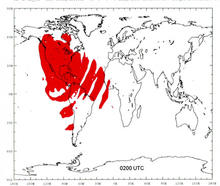
Credit:
NIST
| 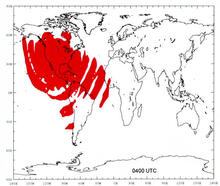
Credit:
NIST
|
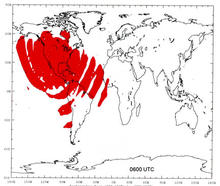
Credit:
NIST
| 
Credit:
NIST
| 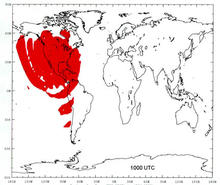
Credit:
NIST
|
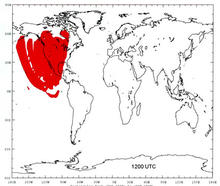
Credit:
NIST
| 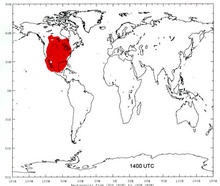
Credit:
NIST
| 
Credit:
NIST
|

Credit:
NIST
| 
Credit:
NIST
| 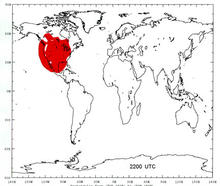
Credit:
NIST
|
These maps are based on a field strength of 100 microvolts per meter, which in theory should be a large enough signal for most receivers to work with. In fact, some receivers have much better sensitivity (20 or 30 microvolts per meter). However, simply having a large signal doesn't mean that the receiver will work. What really matters is the signal-to-noise ratio, or the size of the signal compared to the size of the electrical noise near the same frequency. Raising the noise level is just as harmful as reducing the signal level. For example, if the radio controlled clock is near a source of interference (like a computer monitor) the noise level will increase, and the clock might not be able to synchronize. If the radio controlled clock is in a building with a metal roof, much of the signal will be blocked. Therefore, the signal level will be reduced, and the clock might not be able to synchronize.
Therefore, use the coverage maps as a rough indicator only. We have heard from many owners of radio controlled clocks whose clocks do not work inside the coverage area shown on the maps. This is probably due to a local source of interference. We have also heard several reports from Alaska that the clocks work fine, even though Alaska is outside the coverage area shown on the maps. This is probably due to the low amount of radio "background" noise found in a sparsely populated area.
What to Do When They Don't Work
NIST provides the signal received by your radio controlled clock, but we cannot provide technical support for the clocks themselves. We didn't manufacture them, and we are not familiar with all the models or all of their features. We recommend that you save the instruction sheet that came with your clock, so you can refer to in the future if necessary. Having said that, we can offer a few general tips about what to do if your radio controlled clock isn't displaying the correct time.
My clock doesn't synchronize at all
Most WWVB radio controlled clocks work great, as evidenced by the hundreds of thousands of units that have been sold throughout the United States. However, if your radio clock or receiver isn't working, we suggest:
- If your clock uses batteries, check them and replace if necessary.
- If you have a desk top unit, try rotating it 90 degrees. If you have a wall clock try mounting it on a wall perpendicular to the one it is currently on (e.g. if it is on a north-south wall try an east-west wall). The antennas are directional and you might be able to improve the signal strength by turning the antenna.
- Place the clock along a wall or near a window that faces Fort Collins, Colorado.
- Locate the clock at least 1 or 2 meters away from any computer monitors, which can cause interference (some monitors have a scan frequency at or near the WWVB carrier frequency of 60 kHz).
- If nothing else works, take the clock outdoors at night and power it down (remove the batteries or unplug it), then power it up again to force it to look for the WWVB signal. If it works outdoors but not indoors, you probably have a local interference problem inside your house or building. If it doesn't work outdoors at night, it's probably best to return it and try a different model.
- The shielding provided by a metal building might prevent the clock from working. For example, if you live in a mobile home or a house with steel siding, the clock might not work.
- If you think your clock is defective, ask the manufacturer or dealer about obtaining a replacement.
My clock is off by one or more hours
Remember, minutes and seconds are the same in all time zones within the WWVB coverage area; only hours are different. If your clock is off by one or more hours, it probably has to do with a time zone setting. Make sure you have properly selected your time zone using the instructions that came with your radio controlled clock.
If you live in an area that does not observe Daylight Saving Time (Arizona or Hawaii), make sure that DST is disabled on your radio controlled clock. Not all clocks have this feature, so you might have to select another time zone to make your clock display the correct time when DST is in effect.
Some radio controlled clocks only allow you to select four different time zones (Pacific, Mountain, Central, and Eastern). Some clocks allow you to select any time zone, even those time zones that are outside the coverage area. When purchasing a clock, make sure that it can handle your time zone. For example, we've heard from a few users who purchased clocks in Hawaii but can't select the Hawaiian Time Zone.
My clock is off by a few minutes or seconds
This can be due to a number of different problems as listed below:
Reception Problem - If your clock isn't currently receiving the signal, the time will "drift" and gradually get further and further from the correct time. Remember, if the signal isn't being received, your clock isn't radio controlled any longer, it's just a regular quartz clock. Its accuracy will depend on the quality of the quartz crystal. Most quartz clocks can keep time to 1 second per day or better, but some will be off by several seconds per day.
Most digital radio controlled clocks have an indicator on the display that tells you if the signal is being received properly. Some analog clocks have an audio indication (a usa-button you can push that indicates through a series of tones or beeps if the signal is there). If you are not sure if the signal is being received, try powering down the clock (unplug it or remove the batteries), then turn it on again to see if it can synchronize. If it doesn't, see the tips above for improving your reception.
Alignment Problem - If you have an analog clock, it's possible that the hands aren't properly aligned. This could cause the clock to be off by a second or more even if it is receiving the signal properly. The clock might not have been properly aligned at the factory, or it might have been jostled during shipment, causing the hands to move. Some manufacturers explain how to align the hands on their instruction sheet. If you aren't sure how to do this, and the small error bothers you, it's best to return the clock.
Checking your clock - There is no need to check a properly working WWVB clock, it should always display the correct time. However, you might want to check it if you suspect you have a problem. You can check your clock by using the NIST web clock, or by listening to NIST Radio Station WWV using a shortwave radio or telephone (dial 303-499-7111).
When checking an analog clock, make sure you are looking straight at the clock face, and not viewing it from an angle. If you view if from an angle, you can think it's off by a few seconds, even if it's not. This is similar to trying to read the speedometer from the passenger seat of a car, and thinking the speed is faster or slower than it actually is.
We switched to Daylight Saving Time, and my clock didn't change
This is probably due to a reception problem. Your clock hasn't received the signal recently, so it didn't know about the time change. Most digital radio controlled clocks have an indicator on the display that tells you if the signal is being received properly. Some analog clocks have an audio indication (a usa-button you can push that indicates through a series of tones or beeps if the signal is there). If you are not sure if the signal is being received, try powering down the clock (unplug it or remove the batteries), then turn it on again to see if it can synchronize. If it doesn't, see the tips above for improving your reception.
Also, some clocks have a way to disable Daylight Saving Time. Make sure it isn't disabled if your area observes DST.
My clock switched to Daylight Saving Time, but we don't observe DST where I live
There is most likely an on/off toggle for DST. Turn it off if your area does not observe DST. Contact the manufacturer about how to do this. If there isn't a way to turn DST off, you may have to change your time zone setting during DST to make your clock display the correct time.
Contacts
-
NIST Radio

